Understanding Bokeh: The art and science behind the beauty of blur (part 1)
posted Wednesday, September 11, 2013 at 5:56 PM EDT
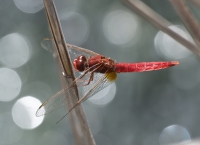
The term bokeh gets bandied about with some degree of abandon these days, as fashionable or trendy words tend to be. And it's not just popular among the Instagram hipsters. Serious photographers and beginner shooters alike seem to be bonkers for bokeh.
A few of you might have heard the term but may still not know exactly what bokeh is. Bokeh is derived from a Japanese word meaning "blurred" or "hazy," and it's used to describe the character of the out-of-focus areas of a photographic image. There is good and bad bokeh, and judging what's aesthetically pleasing and what's not is entirely subjective.
The overall perception of the character of image blur is, literally, in the eye of the beholder. We all have different tastes. Thus, we have to rely on value judgments to describe it with such adjectives as smooth and creamy or, conversely, hard-edged and harsh. There are no objective measures for bokeh -- nobody has created a "Bokeh-o-meter" -- as far as I know.
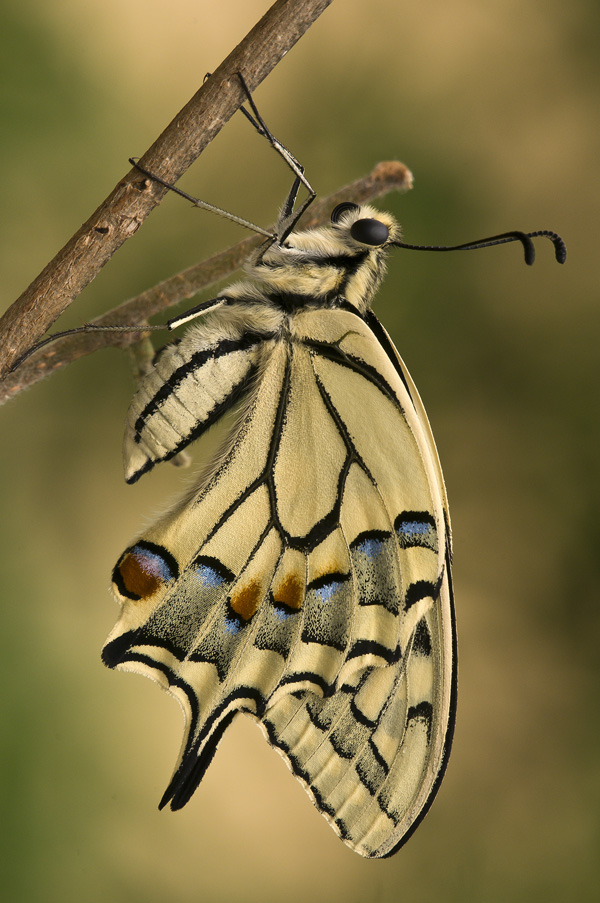
Photo by Paul Harcourt Davies
Bokeh plays an important compositional role that makes us consider the parts of an image that are not in focus and are separated from the main subject. These blurred areas have often been dismissed as "just the background" by those who don't know any better. However, experienced photographers realize the background has a significant psychological impact in setting the mood of a shot and, in a practical sense, can enhance the apparent sharpness of the subject, or otherwise accentuate it through contrast in color and texture.
As far as I can determine, bokeh first appeared as a term relating to Western photography in recent history when Mike Johnston introduced it in an 1977 issue of Photo Techniques magazine. Much has been written since then, including guides to the term's correct pronunciation -- and explanatory YouTube videos -- revealing how you, too, can be a photo nerd and leap to correct your (ex) friends.
I'll put my photo nerd hat on and hopefully not offend you: The term is not pronounced boke (as in poke), or even bo-kay (as in Bouquet). There are two syllables pronounced without noticeable pause between them: the bo (as in bone or boat) and a short ke (as in kettle or kelp) assuming that your pronunciation of these is standard. But then English (the U.K. or American version) is a capricious tongue and someone is sure to correct you no matter how you say it. (My friend and fellow IR contributor Steve Meltzer sent me this, which seems appropriate: http://www.livescience.com/33652-americans-brits-accents.html.)
Looking closer at bokeh
Bokeh is most strongly in evidence with large aperture lenses of all sorts where the depth of field will inevitably be shallow and large areas may be out of focus. Longer focal length lenses -- telephotos and macro lenses -- accentuate the blur for artistic effect when used at their widest apertures or closed down to about f/5.6 or f/8. Any more, and background detail can be resolved in a distracting way. Medium telephotos used for portraiture work similarly. In fact, bokeh becomes a consideration anywhere where shallow depth of field eliminates background clutter and emphasizes the sharpness of the subject.
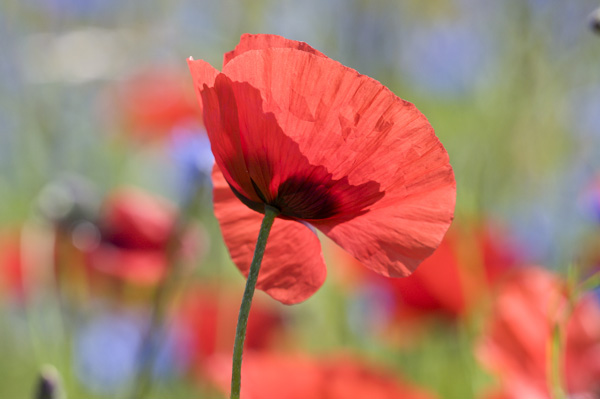

The soft background blurs in the image above (top) made with a 150mm f/2.8 lens contrast strongly with the sharp detail in the 10mm f/2.8 diagonal fisheye (bottom). The mood is completely different, and the wide-angle conveys more information about the surroundings. It is not a question of which is best -- it comes down to what you want to show.
Bokeh tends to be less noticeable with wide lenses unless you are shooting close to a subject at maximum aperture. Typically, a wide-angle lens will render a foreground subject sharp, as well as retaining detail in the background. Meanwhile, telephoto lenses tend to isolate subjects from the background, and it is in that background that bokeh becomes important.
Lenses treat spatial separation of elements in a picture differently according to their focal length -- a good exercise is to photograph a subject with a wide-angle lens and a telephoto and move so that it occupies the same proportion of the viewfinder. With wide-angle lenses you are much closer to a subject than with a telephoto. It all comes down to perspective and the consequence of reducing three dimensions in the real world to the two-dimensional image on a print or screen.
The basis of good bokeh
So, what constitutes "good bokeh"? Well, I'd say a background where highlight blurs have soft edges and demonstrate no sharp distinctions between out-of-focus elements. That basic aesthetic will likely pass the test, though aficionados might well develop finer definitions and, naturally, a specific vocabulary to go with it. And again, I must stress that bokeh is a highly subjective measure. What might look like good bokeh to you and me, might very well not look good to others.
The sharply focused parts of any image can be thought of as points or collections of points, but away from these -- the out-of-focus areas -- the light spreads slightly and those points become tiny circles. These are the so-called blur circles and, we are told, that as long as these circles are no larger than 1/30mm (originally on a 35mm film), then the average human eye cannot distinguish them from a point. This measure was chosen as the diameter of the so-called "circle of least confusion" with 35mm format film work. It is not just a figure plucked from the air, for it has a firmer basis in optics and the way we view prints -- as I shall explain later.
The iris diaphragm and bokeh
We can think of these blurred area as over-lapping circular pools of light where rays have spread out rather than been focused. They are actually diffraction patterns whose edges assume the shape of the lens aperture in the diaphragm through which they pass. If the aperture is a perfect circle, then overlapping images blend beautifully and backgrounds look smooth -- that's good bokeh.
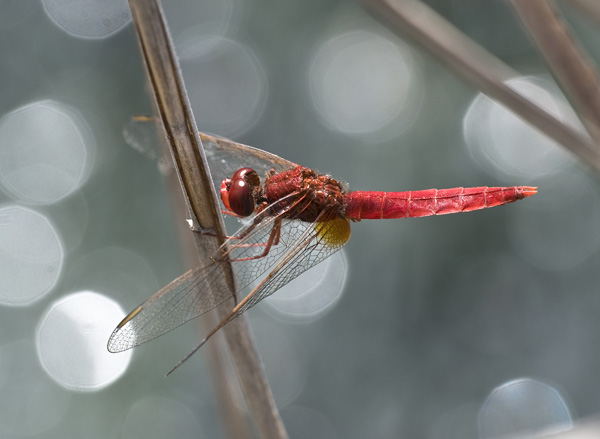
Photo by Paul Harcourt Davies
In the photo above, distant highlights are caused by reflection from a water surface where the dragonfly perches on a stem. At first I found them disconcerting, but then decided I liked them because they show the faint diffraction patterns at their edges, and because the diaphragm is not perfectly circular. The figure is a 9-sided polygon with curved edges -- and reflects the 9-bladed iris diaphragm that created it.
If the diaphragm aperture is not circular, then the angular edges do not produce perfect circles and the bokeh appears slightly harsh, because the overlap is not smoothly accomplished. The greater the number of diaphragm blades, the more perfectly circular the aperture becomes and -- if these blades are slightly curved -- the better the approximation to a circle. In fact, lens specifications nowadays state the number of blades in the diaphragm as a selling point. Typically, seven or nine blades are considered a good start for producing creamy bokeh.
By the way, the individual diffraction patterns never have sharp contours. If you examine them closely with a microscope, the points have a series of rings and at the edges are lines getting fainter at a very small distance from the main portion of the pattern. This is the reason images break up as we enlarge them and no more detail is revealed -- it is called empty magnification. We just make those pattern edges more obvious.

Photo by Paul Harcourt Davies
Bokeh and depth of field
The diagram below shows how a greater depth of field results from smaller apertures. You can move further either side of the sharpest focus and still get what looks like a point. To emphasize bokeh, we need minimal depth of field from wide-open lenses, preferably those of longer focal length.
By increasing the depth of field, blurred elements in a background begin to obtain form and become identifiable. This can be distracting, but again, it is a question of degrees. That slightly soft focus in wide-angle macro photography allows background elements to be obvious but not intrusive, at the same time emphasizing foreground sharpness.
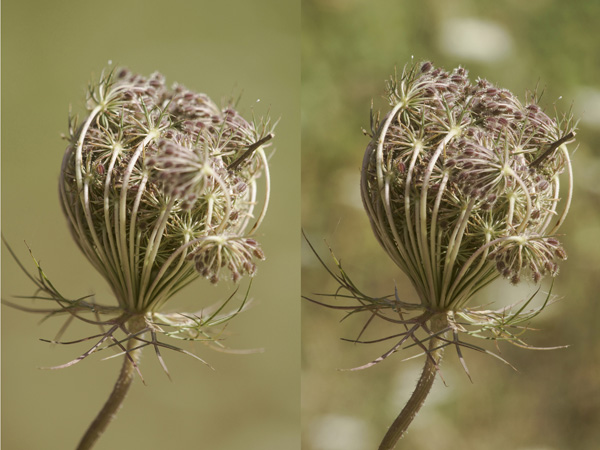
Photo by Paul Harcourt Davies
It is not just the circularity of the lens iris (the diaphragm aperture) that affects bokeh; lens aberrations have a role to play, too. The most important is spherical aberration, a defect that that arises when light rays from the edge of a lens and those from its center are not focused at the same point. It is also affected by internal reflections from lens surfaces -- especially common with older lenses created before the days of lens multicoating started to reduce them.
Spherical aberration determines whether the tiny image disks of the diffraction patterns are uniformly illuminated or not, and thus affects bokeh. Disk brightness can vary from edge to center depending on how effectively the spherical aberration is controlled. Discs can be brighter at center than edge (and vice-versa), and there is also a difference in appearance of these discs behind -- and in front of -- the plane of focus.
Catadioptric and other lenses that produce a special bokeh
An unmistakable bokeh effect occurs with mirror telephoto lenses, also known as catadioptric lenses. These lenses cause out-of-focus highlights to become "donuts." The center of each light disc is blocked out because it is imaging the main mirror in the lens that is, in turn, partially blocked by a secondary mirror inside the lens.
Some like this donut bokeh, and some do not. If you like the donut effect, then you should consider experimenting with a catadioptric lens.
Some other lenses have been designed with the capacity for changing the way the out-of-focus areas appear by increasing the degree of spherical aberration, and there are add-ons to cameras within the LensBaby series, for example, that do the same.
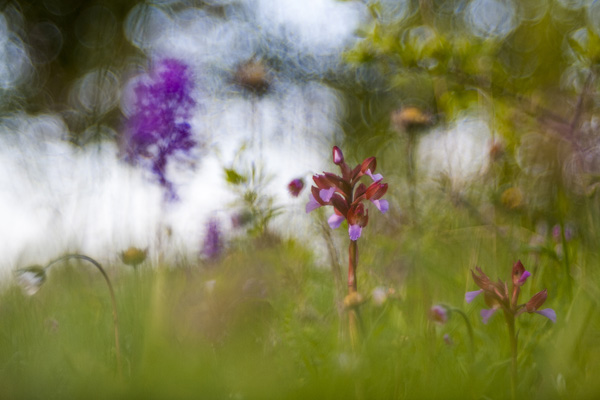
Photo ©Leonardo Battista
In recent years, a particular vintage lens has become a great favorite with nature photographers intent on creativity, and eBay prices have rocketed as a result. The lens is a simple design, a Cooke Triplet that has three strong lens elements separated by comparatively large air spaces. Originally made for Exakta, this is the Meyer-Optik Gorlitz Triplan 1:2.8 100mm lens which many have re-mounted for Canon, Nikon and other systems.
The construction imparts some unique characteristics to out-of focus highlights, giving them an ethereal, soap-bubble look which creates a halo of sorts around light objects. It is extremely effective, but very easy to over-use. In the artistic right hands of proponents such as Sandra Bartocha and Leonard Battista, it can be an amazing creative tool.
If you like to experiment and have a cheap extension tube on hand -- you can easily find an inexpensive one on eBay -- then try an old lens from a slide projector. These lenses have just a few internal elements, all air-spaced, with no internal diaphragm, and can produce very interesting bokeh. Point it at a scene with distinct highlights and you may be surprised at the results!
Paul Harcourt Davies is a long-time professional photographer, and an author of 19 books with a background that fuses technical and artistic elements to his life-long passion for photography of the natural world. We reviewed his e-book (that he co-wrote with frequent collaborator Clay Bolt): Wide-Angle Macro: The Essential Guide a few months ago, and we knew we wanted to share more of his insights and amazing images with our readers. (You can order a copy of the book here.) An experimenter and innovator by nature, he has long been on a mission through his writing and lectures to bring the techniques of macro photography to others. For the last 10 years he has been based in Umbria, central Italy, renovating an old farmhouse with a wild garden from where he organizes tours, workshops and much else.
Be sure to read Understanding Bokeh, Part 2: The fine line between sharpness and blur.